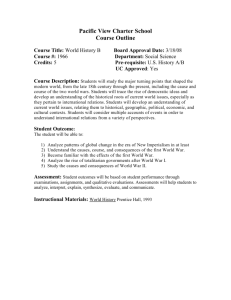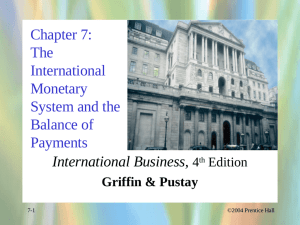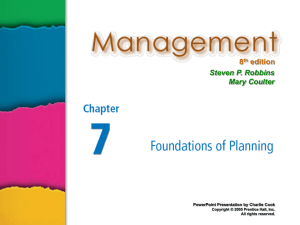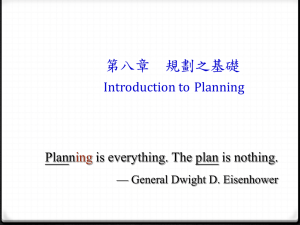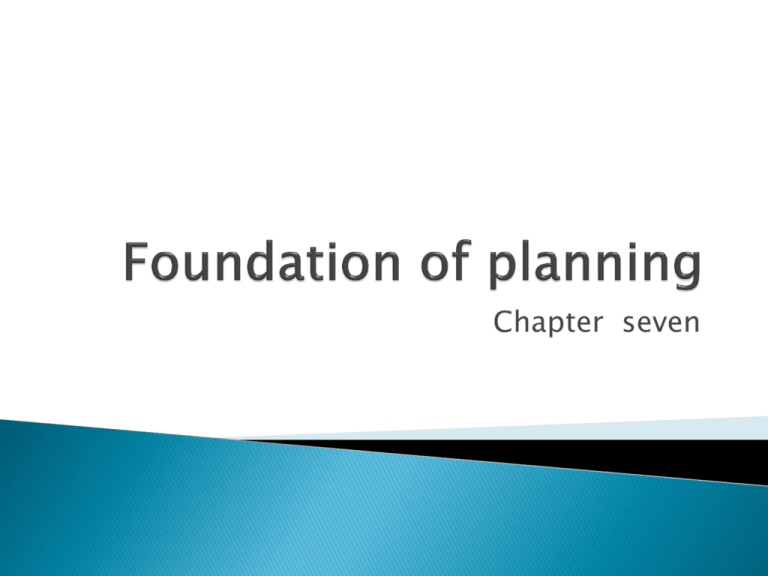
Chapter seven
Define planning
Difference between formal and informal planning
The purpose of planning
The relationship between planning and
performance
Types of goals
Establishing goals
Types of plans
Developing plans
Planning
is defining organization‟s goals,
establishing an overall strategy to achieve
these goals
developing plans to achieve these goals
Planning is concerned with both means and
ends
Ends is what to be done
Means is how to be done
All managers plan
Planning can be formal or informal
Planning
◦ A primary managerial activity that involves:
1.Defining the organization‟s goals
2.Establishing an overall strategy for achieving those goals
3.Developing plans for organizational work activities.
◦ Planning is concerned with both means and ends
◦ Ends is what to be done
◦ Means is how to be done
◦ All managers plan
◦ Planning can be formal or informal
◦ Types of planning
1)Informal: not written down, short-term focus; specific to an
organizational unit.
2)Formal: written, specific, and long-term focus, involves shared
goals for the organization.
7–
4
Informal planning nothing is written down, there is
little or no sharing of goals with others within the
organization, and it lacks continuity
Informal planning is more common in small
businesses but exist in large organizations as well
Formal planning goals are written down, goals are
shared with organization members, specific goals
are defined in limited time
There are specific plans to achieve these goals and
managers define how the goals will be reached
Managers plan for setting goals ,putting strategies to achieve
these goals, developing plans
1)
Purposes of planning:
It provides directions to managers and nonmanagers as well so
all employees know what to do and how to do ,without planning
there might there be cross-purpose which prevent organization
from achieving it‟s goals
2)
Reduce uncertainty by forcing managers to look ahead and
adopt change and know how to respond to it
3)
Minimizes waste and redundancy
4)
Planning establishes standards used in controlling
Planning and performance:
There is a positive relationship between planning and
performance
Formal planning is associated with positive results such as high
profits,higer returns on assets
Planning and implementing plans lead to higher performance
Planning/performance relationship is influenced by the planning
time frame as organizations need at least four years of formal
planning before seeing any effect on performance
◦ The external environment can reduce the impact of planning
on performance,
Planning is called the primary management function
because it is the basis of all other things that managers
do
Planning involves two important elements: goals and
plans
Goals
are desired outcomes for individuals,groups,or entire
organizations and guide all management decisions,
goals are called objectives
Plans
are documents that outline how goals are going to be
met includes resources and time frames ,as managers
plan they develop both goals and plans
There are four types of goals: financial-strategic-stated-real
All organizations have multiple goals not just one single goal
Using a single goal can result in unethical practice because
manager and employees will ignore the other objectives
Financial goals are related to the financial performance of the
organization
Strategic goals are related to the other areas of an organization
performance
Stated goals are official statements of what organization says,
and it wants its various stakeholders to believe its goals are
Real goals are what an organization actually pursue and observe
what organization members are doing, actions define priorities
Financial Goals
◦ Are related to the expected internal financial performance of
the organization.
Strategic Goals
◦ Are related to the performance of the firm relative to factors in
its external environment (e.g., competitors).
Stated Goals versus Real Goals
◦ Broadly-worded official statements of the organization
(intended for public consumption) that may be irrelevant to its
real goals (what actually goes on in the organization).
© 2007 Prentice Hall, Inc. All rights
reserved.
7–
10
Plans are documents that outline how goals are
going to be met
There are many types of plans :
Strategic
versus operational
Long term versus short term
Directional versus specific
Single use versus standing
Strategic Plans
◦ Apply to the entire organization.
◦ Establish the organization‟s overall goals.
◦ Seek to position the organization in terms of its environment.
◦ Cover extended periods of time.
Operational Plans
◦ Specify the details of how the overall goals are to be achieved.
◦ Cover short time period.
© 2007 Prentice Hall, Inc. All rights
reserved.
7–
12
Long-Term Plans
◦ Plans with time frames extending beyond three years
Short-Term Plans
◦ Plans with time frames on one year or less
Specific Plans
◦ Plans that are clearly defined and leave no room for
interpretation
Directional Plans
◦ Flexible plans that set out general guidelines, provide focus,
yet allow discretion in implementation.
© 2007 Prentice Hall, Inc. All rights
reserved.
7–
13
Single-Use Plan
◦ A one-time plan specifically designed to meet the
need of a unique situation.
Standing Plans
◦ Ongoing plans that provide guidance for activities
performed repeatedly , standing plans include
rules, procedures, policies
© 2007 Prentice Hall, Inc. All rights
reserved.
7–
14
© 2007 Prentice Hall, Inc. All rights
reserved.
7–
15
Goals provide directions for all management decisions
These goals can be established through process, either
traditional goal setting or management by objectives
Traditional goal setting is an approach to setting goals
in which goals are set at the top level of the
organization and then broken into sub goals for each
level of the organization
this approach assumes that top managers know what is
the best
Management by objectives (MBO) is a process of setting
mutually agreed-upon goals to evaluate employee
performance
Specific goals are jointly determined by employees and
their managers
Traditional Goal Setting
◦ Broad goals are set at the top of the
organization.
◦ Goals are then broken into subgoals for each
organizational level.
◦ Assumes that top management knows best
because they can see the “big picture.”
◦ Goals are intended to direct, guide, and
constrain from above.
◦ Goals lose clarity and focus as lower-level
managers attempt to interpret and define the
goals for their areas of responsibility.
© 2007 Prentice Hall, Inc. All rights
reserved.
7–
17
© 2007 Prentice Hall, Inc. All rights
reserved.
7–
18
Management By Objectives (MBO)
◦ Specific performance goals are jointly determined by
employees and managers.
◦ Progress toward accomplishing goals is periodically reviewed.
◦ Rewards are allocated on the basis of progress towards the
goals.
◦ Key elements of MBO:
Goal specificity, participative decision making, an explicit
performance/evaluation period, feedback
© 2007 Prentice Hall, Inc. All rights
reserved.
7–
19
1. The organization‟s overall objectives and strategies are
formulated.
2. Major objectives are allocated among divisional and
departmental units.
3. Unit managers collaboratively set specific objectives for their
units with their managers.
4. Specific objectives are collaboratively set with all department
members.
5. Action plans, defining how objectives are to be achieved, are
specified and agreed upon by managers and employees.
6. The action plans are implemented.
7. Progress toward objectives is periodically reviewed, and
feedback is provided.
8. Successful achievement of objectives is reinforced by
performance-based rewards.
© 2007 Prentice Hall, Inc. All rights
reserved.
7–
20
Reason for MBO Success
◦ Top management commitment and involvement
Potential Problems with MBO Programs
◦ Not as effective in dynamic environments that require constant
resetting of goals.
◦ Overemphasis on individual accomplishment may create
problems with teamwork.
◦ Allowing the MBO program to become an annual paperwork
shuffle.
© 2007 Prentice Hall, Inc. All rights
reserved.
7–
21
• Written in terms of
outcomes, not actions
Focuses on the ends, not
the means.
• Measurable and
quantifiable
Specifically defines how the
outcome is to be measured
and how much is expected.
• Clear as to time frame
How long before measuring
accomplishment.
• Challenging yet attainable
Low goals do not motivate.
High goals motivate if they
can be achieved.
• Written down
Focuses, defines, and
makes goals visible.
• Communicated to all
necessary organizational
members
Puts everybody “on the
same page.”
© 2007 Prentice Hall, Inc. All rights
reserved.
7–
22
1.
Review the organization‟s mission statement.
Do goals reflect the mission?
2.
Evaluate available resources.
Are resources sufficient to accomplish the mission?
3.
Determine goals individually or with others.
Are goals specific, measurable, and timely?
4.
Write down the goals and communicate them.
Is everybody on the same page?
5.
Review results and whether goals are being met.
What changes are needed in mission, resources, or goals?
© 2007 Prentice Hall, Inc. All rights
reserved.
7–
23
© 2007 Prentice Hall, Inc. All rights
reserved.
7–
24
Establishing a formal planning department
◦ A group of planning specialists who help managers write
organizational plans.
◦ Planning is a function of management; it should never become
the sole responsibility of planners.
Involving organizational members in the process
◦ Plans are developed by members of organizational units at
various levels and then coordinated with other units across the
organization.
© 2007 Prentice Hall, Inc. All rights
reserved.
7–
25
Contingency Factors in A Manager‟s Planning
◦ Manager‟s level in the organization
Strategic plans at higher levels
Operational plans at lower levels
◦ Degree of environmental uncertainty
Stable environment: specific plans
Dynamic environment: specific but flexible plans
◦ Length of future commitments
Commitment Concept: current plans affecting future
commitments must be sufficiently long-term to meet
those commitments.
© 2007 Prentice Hall, Inc. All rights
reserved.
7–
26
As organizational environments have become more
uncertain and the definition of long-- term has
changed
Specific plans would be preferable than directional as
they have clearly defined objectives
When uncertainty is high directional plans would be
better as they are flexible
Standing plans include rules, procedures, policies
Goals are not all created equal, some goals are
better at stated desired outcome than others
Well designed goals should be:
1.
2.
3.
4.
5.
6.
written in terms of outcomes rather actions
can be measured
clear as to a time frame
challenging but attainable
written down
communicated to all organization members
Effective Planning in Dynamic Environments
1) Develop plans that are specific but flexible.
2) Understand that planning is an ongoing process.
3) Change plans when conditions warrant.
4) Persistence in planning eventually pay off.
5) Flatten the organizational hierarchy to foster the
development of planning skills at all organizational
levels.
© 2007 Prentice Hall, Inc. All rights
reserved.
7–
29
Criticisms of Planning
◦ Planning may create rigidity.
◦ Plans cannot be developed for dynamic environments.
◦ Formal plans cannot replace intuition and creativity.
◦ Planning focuses managers‟ attention on today‟s
competition not tomorrow‟s survival.
◦ Formal planning reinforces today‟s success, which may lead
to tomorrow‟s failure.
© 2007 Prentice Hall, Inc. All rights
reserved.
7–
30
I.
1)
Answer the following questions
Define planning and show the difference between formal and
informal planning
2)
What is the relationship between planning and performance?
3)
What are the purposes of planning?
4)
What are the two elements of planning?
5)
What are the different types of goals?
6)
What are the different types of plans?
7)
What are the characteristics of well designed plan
II.
Mark true or false:
1)
Goals provide directions to all management decisions
2)
In traditional goal setting, goals are set at the top of the organization
3)
Top managers know what is the best as they see the whole picture
4)
MBO decreases employees „performance
5)
Well designed goals can‟t be measured
6)
According to MBO programs, there could be cross-purposes
7)
In formal planning nothing is written down
8)
Some small business may have formal planning
9)
Planning maximize waste and redundancy
10)
Planning reduce uncertainty
11)
There is a negative relationship between planning and performance
12)
Stated goals are what an organization says and wants its
stakeholders to believe
13)
Actions define priorities
14)
According to the time frame, plans are either single use or standing
15)
According to breadth, plans are either short term or long term
16)
Goals are all created equal
17)
Well designed goals should be challenging and unattainable


